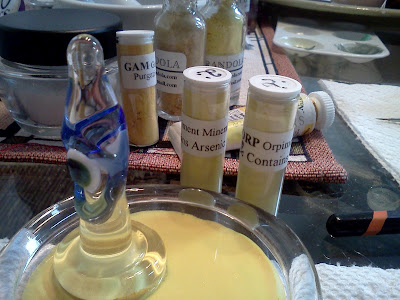Medieval artists didn't have the benefit of modern conveniences like premixed tubes of paint, or other ready-to-use materials. What they did have, was a deep understanding and connection with their tools and materials. In this post, I try to learn and understand the use of yellow pigment.
Last updated - September 19, 2012
Last updated - September 19, 2012
"Off all their uses, perhaps the least important was to represent yellow things" - (Thompson 174)
 |
| "French Ochre" at various stages of mulling and added calcium. |
Obtained from Guild Mirandola
There is something very pleasing about the colour of this pigment, a golden quality that shines through from it's humble origins and adds a richness to the page on which it is used.
Although I have now used this pigment a number of times on various works, this is the first time I have really sat down and played with it. It is an earth pigment, which means it has a gritty feel and needs further refining for a smooth finish. Cennini recommends ". . . working up with clear water; and work it up thoroughly, for it goes on getting better." (27). I found this to be very true, the more I mulled the finer the pigment became taking on a silky quality to it.
Although Cennini doesn't include calcium-carbonate (chalk, eggshells) in his instructions for working up ochre, he does mention it for other earth pigments. I figured it was a least worth playing with, and my results can be seen in the photo.
 |
| "Orpiment Hue" and "W&N Brilliant Yellow" |
Obtained from Guild Mirandola
I had assumed this to be a safe modern pigment since there is no warning on the label, and thankfully this was later confirmed by Guild Mirandola.
It worked up incredibly easily and went on smoothly, however I'm not sure why but I find my sample very ordinary. For some reason I was expecting more from a pigment colour of this name, maybe it was an unreasonable expectation. I feel like it lacks a certain vibrancy, and it reminds me of the Windsor & Newton tube gouaches that I am moving away from.
I will be playing with this pigment some more, since it is a good substitute for regular use.
 |
| "Orpiment" at various stages of mulling |
Obtained from Master John the Artificer
Cennini calls orpiment ". . . a handsome yellow more closely resembling gold than any other colour." (28) and, according to him, it is another one of those pigments that can be worked up indefinitely as it only gets better and better.
He does however present us with a couple of warnings.
Firstly, it will turn black with exposure to air. This I find curious, and am interested to see how my colour samples fair over time (these initial samples are all mixed pigment, water and gum arabic). Although I can not pin-point the source right now, I do remember hearing that thorough mixing with glair instead of gum arabic gives the pigment a coating of protein that protects it from reaction, (there's an experiment for later in there somewhere I think!)
Secondly, my favourite, and how he ends his chapter on orpiment ". . . beware of soiling your mouth with it, lest you suffer personal injury." (29) Yeah, arsenic will do that to you!
I was very impressed with how this mixed up. The more and more this was mulled, the silkier is became and the nicer it seemed to apply to the the page. The pigment I have has a slight orange cast to it, preventing it from being a true yellow in the modern sense but that is one of the reasons I like it, it just isn't as glaringly bright.
Works Cited & Bibliography
BUCKLOW, Spike. The Alchemy of Paint - Art, Science and Secrets from the Middle Ages. London: Marion Boyars Publishers Ltd., 2009. Print.
CENNINI, Cennino D' Andrea. The Craftsman's Handbook. The Italian "Il Libro dell' Arte." Translated by Daniel V. Thompson, Jr. Mineola: Dover Publications, Inc., 1933. Print.
THOMPSON, Daniel V. The Materials and Techniques of Medieval Painting. Mineola: Dover Publications, Inc., 1956. Print.
Websites
Douma, Michael, curator. "Orpiment." Pigments through the Ages. 2008. Institute for Dynamic Educational Development. August 18, 2012. < http://www.webexhibits.org/pigments/indiv/overview/orpiment.html >
